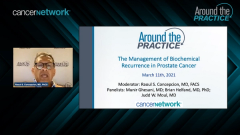
Best Practices for Monitoring After Definitive Therapy in Prostate Cancer
Dr Judd Moul and colleagues discuss best practices for monitoring patients with prostate cancer after definitive therapy.
Episodes in this series

Raoul S. Concepcion, MD, FACS: Let’s go to the next polling question, please. For patients who do have a biochemical recurrence, initial therapy should always be androgen deprivation therapy. Is that true or false? Let me put that in context. When I’m saying androgen deprivation therapy, I am talking about either bilateral orchiectomy, or initiation of an LHRH [luteinizing hormone-releasing hormone] analogue.
Polling question 2: For patients who do have a biochemical recurrence, should initial therapy always be androgen deprivation therapy? We’ve got about 40% who said true and 60% who said false. Patients who have been definitively treated for prostate cancer, whether it’s surgery or radiation, in your practice, you’ve been doing a ton of radical prostatectomies for years. How do you generally follow those patients after surgery or after radiation? What is your standard protocol relative to monitoring these patients, in general?
Judd W. Moul, MD: Well first off, thanks so much for inviting me to be part of this tonight; it’s really an honor to be here. I would say for most of my patients who have surgery, I’m typically seeing them back about every 3 months for the first year, and if they have particularly high-risk features, I might see them back every 3 or 4 months for the first 2 or 3 years. Most of the lower-risk patients end up coming back every 6 months for the first 2 or 3 years, and I like to see them annually, at least out to 10 years for my surgical patients. I try to see my own patients back. However, not all the patients do come back because some of them are a far distance away. I think as a surgeon, it’s important. I appreciate seeing my own patients, so most of my patients I try to encourage to come back. Even for the radiotherapy patients, we have a joint practice, and a multidisciplinary program. I work closely with a couple of academic radiation oncologists. We typically split the follow-up. Therefore, even if I refer a patient to radiation, many times, it’s been my patient, and I will alternate 6-month visits with the radiation oncologist for the first even 5 to 10 years.
Raoul S. Concepcion, MD, FACS: Brian, is that your pattern at NorthShore University HealthSystem?
Brian Helfand, MD, PhD: I would say it’s very similar. Thank you also for the invitation, I think this is great. I have a similar protocol. In general, I check their PSAs [prostate-specific antigen levels] every 3 months for the first year, every 4 months for the second year, and every 6 months from there on out. I do that for several reasons. I like to continue that relationship and look at the outcomes. I keep track of all of that. Sometimes, the meaning of what a recurrence is, or how we interpret that once they get out into the real world, or when their primary care physician is looking at it, often gets construed. Therefore, a PSA value of 2 [ng/mL] will often be considered in that setting a good value, and so it’s potentially stopping that from happening.
Transcript edited for clarity.
Newsletter
Stay current with the latest urology news and practice-changing insights — sign up now for the essential updates every urologist needs.































